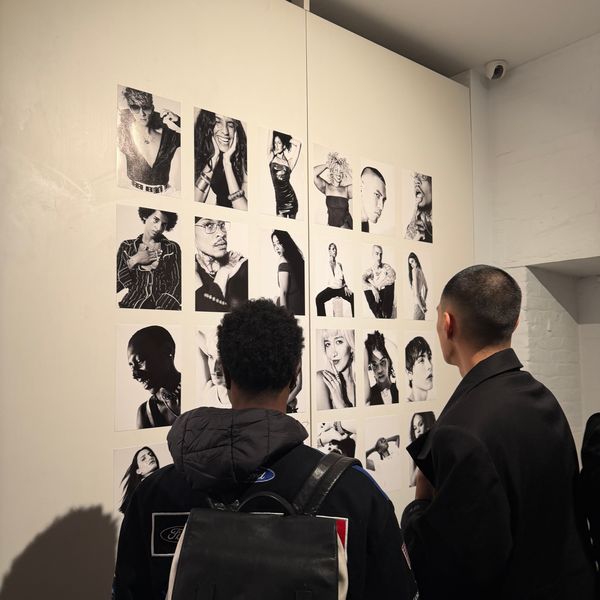This Designer Repurposes Old Celine Wool and 18th-Century Upholstery Fabric
Inside the Upper East Side studio of ONE OF designer Patricia Voto.

As ONE OF’s Patricia Voto was expanding her Upper East Side studio into an additional floor, she rediscovered an old framed black-and-white photograph of a matador. Clad in a traditional bolero and capri-pant set, he now presides over her space from his perch atop the mantle. “I was looking at all the beautiful beadwork like, ‘I wonder if next season has this hint of matador?’” muses the designer. “And that was the jumping-off point.”
Her eighth collection then combined the influence of the matador’s bolero set with eighteenth-century Spanish ballgowns and Christian Dior’s ’50s full skirts and nipped waists. The corresponding moodboard, left splayed upon one wall of the studio, is a visual symphony of references and materials. On one side, you’ll find a harmonic assembly of concho-embellished pieces of outerwear from Flowers of the Killer Moon set against structured floral frocks and austere, vintage Prada. On the other floats the medium that will bring the ideas to life: densely bunched sequins, watercolor-like floral chiffon, and an array of dainty polka-dotted materials.

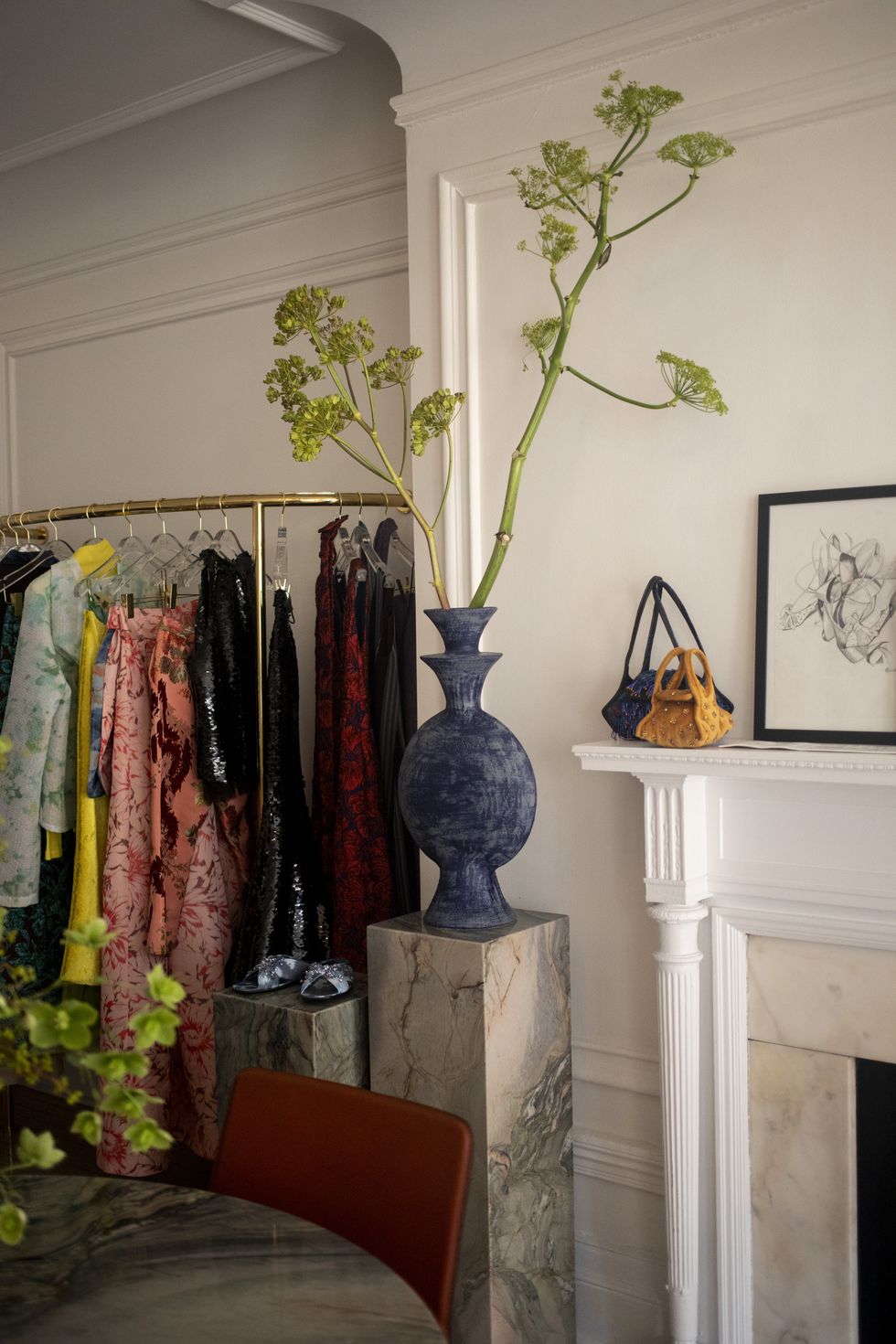
Voto, whose résumé includes stints with designers like Joseph Altuzarra and Rosie Assoulin, designs fabric-first. She rescues unused, high-quality fabrics from the landfill. This season, that entailed a polka-dot rubber leftover from Marc Jacobs’s Fall 2011 collection (coincidentally, Voto was an intern at the brand during the time). The fabric, according to Voto, necessitated a poncho silhouette. There’s also double-face stretch wool, leftover from Old Celine.“We often get a lot of her [Phoebe Philo’s] fabrics. I try to be mindful. She did these wide-leg pants with it, so we did a slim kick-flare.” Not every scrap boasts the same designer pedigree, but they do share the same standards of quality. This season, there’s embossed croc, pony hair, and ornate stretch jacquard—the latter, an anomaly of a fabric.
Despite a robust 12-look collection, Voto’s clients often come to her for a custom experience (bridal also makes up a significant portion of her business). Among the custom pieces in her atelier are a swing coat made from Venetian fabric, and a skirt made from feathered eighteenth-century Jacquard panels intended for upholstery. Voto, who began her career in interior design, loves to incorporate fabrics from that realm. By default, the threat of fabric scarcity ignites an urgency in her clients. The repeat customer knows: “Fabric can be here one day, and gone the next.”
Ahead, Voto parses through her career and personal background, her approach to collecting, and her guilty pleasures—it’s not all high-end design.
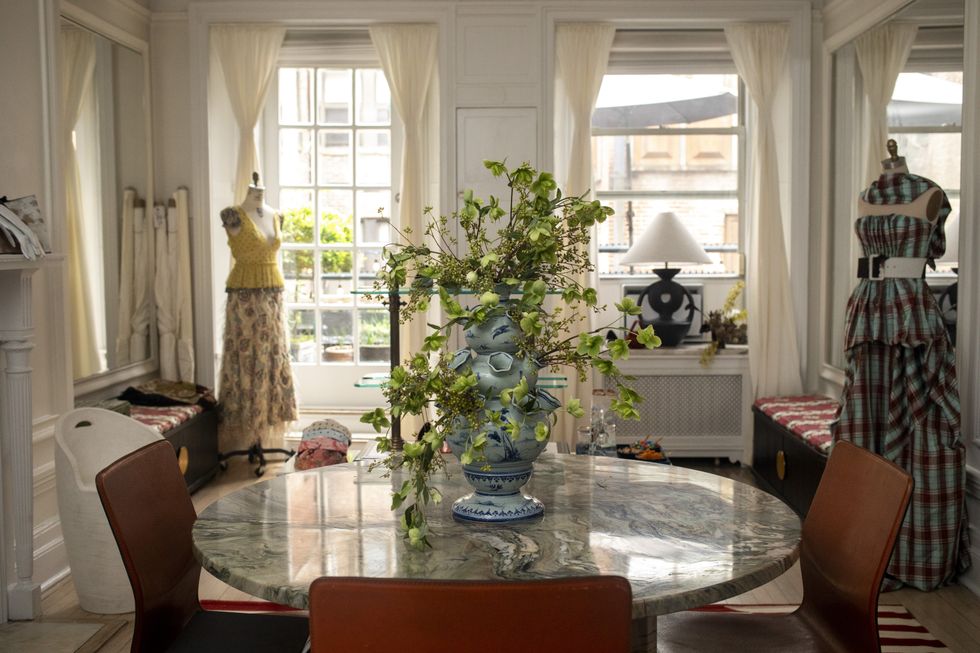
Coveteur: When you make something custom, do you start from scratch? Or do you use current collections as a jumping off point?
Patricia Voto: “We start from scratch. It really depends on the client. Every experience is really tailored to their needs. When somebody comes in, they might be really creative and have a vision in mind, and I'm not about to waver on that. If somebody has something they want, let's get there. And then you have others who really need the support of a physical item to get them going. And then you have everybody in between. With this one client in particular, we do everything from scratch, because she wants one-of-a-kind only. She takes up a significant portion of our pattern closet. We archive all the patterns; she has her own shelf at this point.
I'm sure it's a mixed bag, when people come to you, do you find that they are so excited because they haven't found anyone else doing this? Or are they really just coming to you for your aesthetic specifically?
PV: “So the brides tend to come to us because they had a friend who they know who came, and we made this after-party look for them. With other clients, maybe they need a fortieth birthday dress and it evolves from there. Each time, it's different, but I would say now bridal, it's for the aesthetic for sure because they all look at what each other's ordering and that's what they hone in on. But non-bridal, it could be for a variety of reasons.
I definitely think we serve this hybrid role of designer, but also, I don't want to call ourselves dressmakers, because we're not, but in a way, we've absorbed that into our scope. We're able to source really unique and special fabrics, which a dressmaker doesn't have. Our non-bridal clients might have a perfect pair of pants that they can't get from a brand anymore, so they come in like, "Can you make these in 20 different colors for me?’ We can, so let's do that. Some of the projects aren't as creative, but we serve a really important purpose for them in the sense of creating those uniform pieces.”
It's a good gateway drug. With bridal, it seems like, ‘Oh yeah, I could get a custom wedding dress,’ but you don't think that way with ready-to-wear anymore.
PV: “Oh, so true. Because we work with such a range of ages, you have some who come in and they shopped this way when they were young; it was normal. You go to a tailor, you pick your fabrics, you pick your silhouette. So for some of our clients, it's an old-school way of working. For others, it's so novel and exciting, because they don't know it at all. A dear family friend—she grew up in Argentina and then moved to the States—said she'll never forget the first time she went to a mall. She didn't understand what all the clothes were on the racks, like, ‘What do you mean you buy this? They make it for you?’ It was such an abstract thing for her. That was in the seventies, so in Argentina at that time, they were having everything made to order, but here with industrialization, mass market, and this kind of automation and bulk production totally changed our relationship with clothes. And so educating these younger generations that it's not really that special in the context of history at least. But when you look at it against what's out in the market right now, it is.”
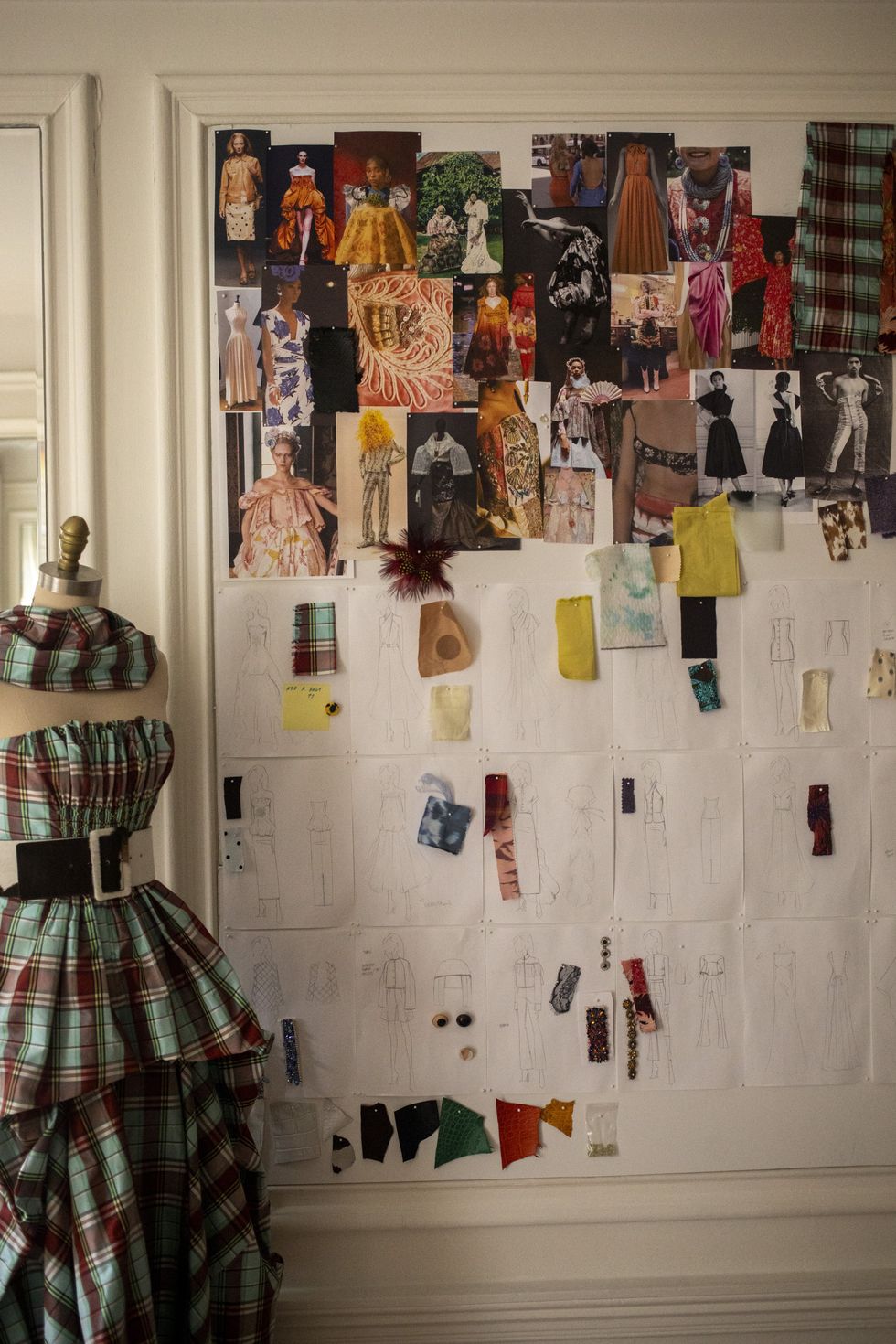

Do you find it fun to have your client come in and get excited about all of these things, and you're almost playing a little? Does it give you some zest versus only working behind the scenes?
PV: “Even at Altuzarra when I worked with Joseph, we were like two nerds who were making these really sexy clothes, and that was so much fun. My job was always to help see someone's vision through, the right hand to the creative director. Now, we put our clients in that role. But back to that question about zest. I get such a high from it. When I see a client come out and they're so happy and they feel so excited, some on the verge of tears, to know that we've comforted them in that way, there is no better feeling. You can't beat it. You've made somebody happy. What's better than that? And the behind-the-scenes thing—could I have named this Patricia Voto? Sure. I always wanted to be behind the scenes. It's not about me. None of this is about me. This is really about being that connector, that broker, helping people see it through. That's why I chose to name it One/Of, and it could be for one of a kind. Everybody can interpret the name how they want, but for me, we're just here to be collaborative.”
I want to take you back, because I love asking creatives about how they built their aesthetic. What are the first things in this aesthetic realm you remember being obsessed with? It could be anything: a movie, a designer, a pair of shoes. What were those first things that were speaking to you?
PV: “This is one of my fondest memories—this is going to be really silly—and definitely my first taste of luxury fashion. I went with my uncle to Boston. I was still in junior high. I had heard of Marc Jacobs—I kind of knew. We went into the store, and I got these crazy rubber-soled Marc Jacobs platforms that I still have today. They were on sale, otherwise, I wouldn't have been able to afford them. That's the beauty of Marc Jacobs in general: the talent. To find something that spoke to me so instantly. I was like, ‘Wow, I have to have them.’ I put them on and felt like a totally different person in these shoes. You walk differently when you're wearing something that you really love. It changed my confidence level, and that was my first real taste of it. Those shoes will come with me everywhere. I've had them resoled probably four times now. I think that's really when I started to see the importance of personal style, but also fashion, in general, not only the Pygmalion effect, but the empowerment that something—as frivolous as clothes are—could really set your mood and tone.”
Okay, so you're figuring out that you want to make a career out of this feeling, this world. Who are the North Star designers? How are you dressing? What's on your walls? As you're fleshing this out, what does the personal world of the things that you love look like?
PV: “I went to Parsons, so that was when I was really starting to explore a lot more vintage. At that time, upcycling wasn't quite a thing yet, but at least you could go to a vintage store and find really cool pieces. Also, I was fuller-chested, so it was hard to find things that worked for me. The internships I had really helped me start to define my style a little bit more and learn about what I liked and didn't like. It was a slow build of creating a wardrobe of careful things. At the end of the day, it was about the fabrics. There's a throughline. I fell in love with a print. I fell in love with a color. That tactility, the colors, the materials that really drew me into each piece really stayed with me.”
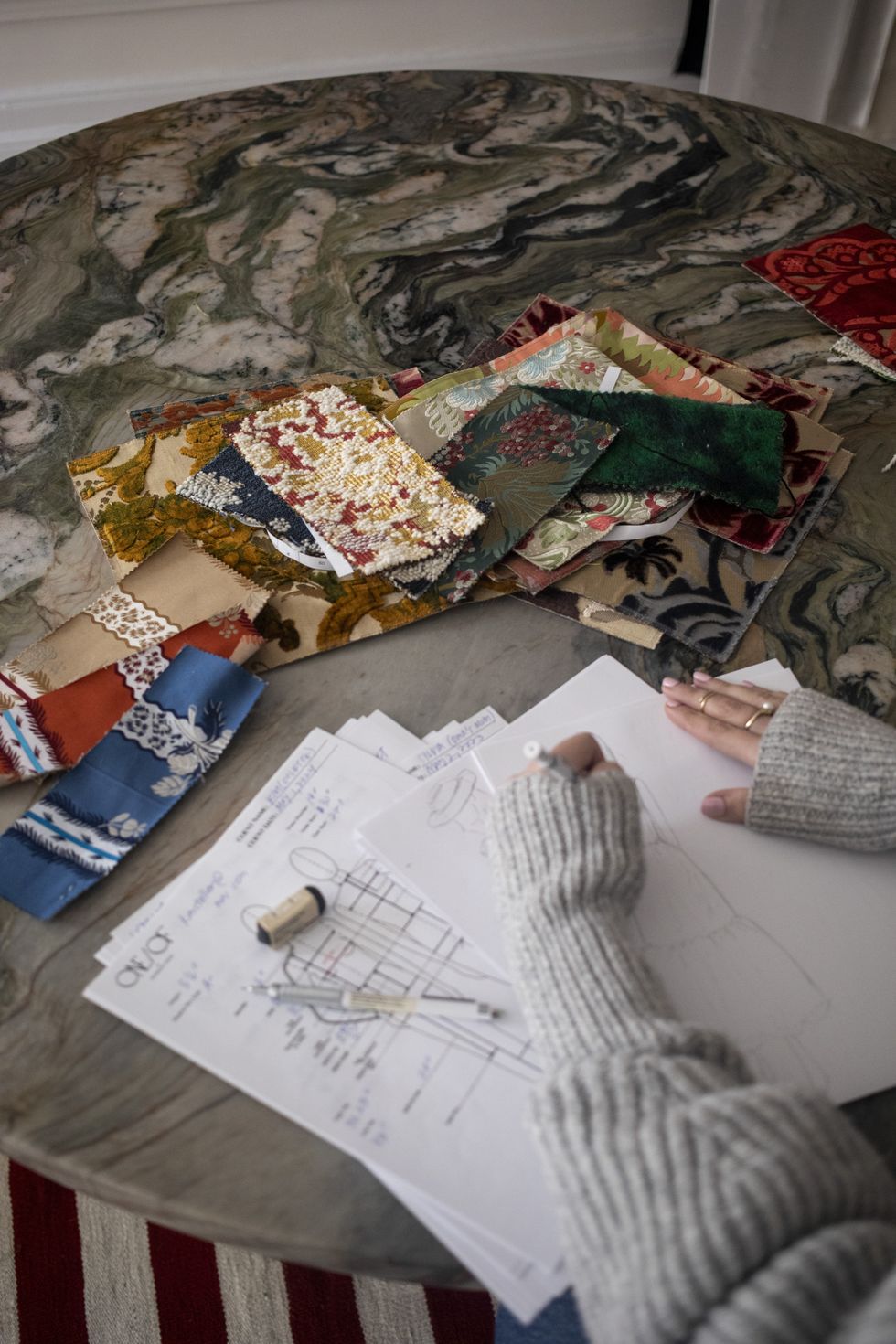
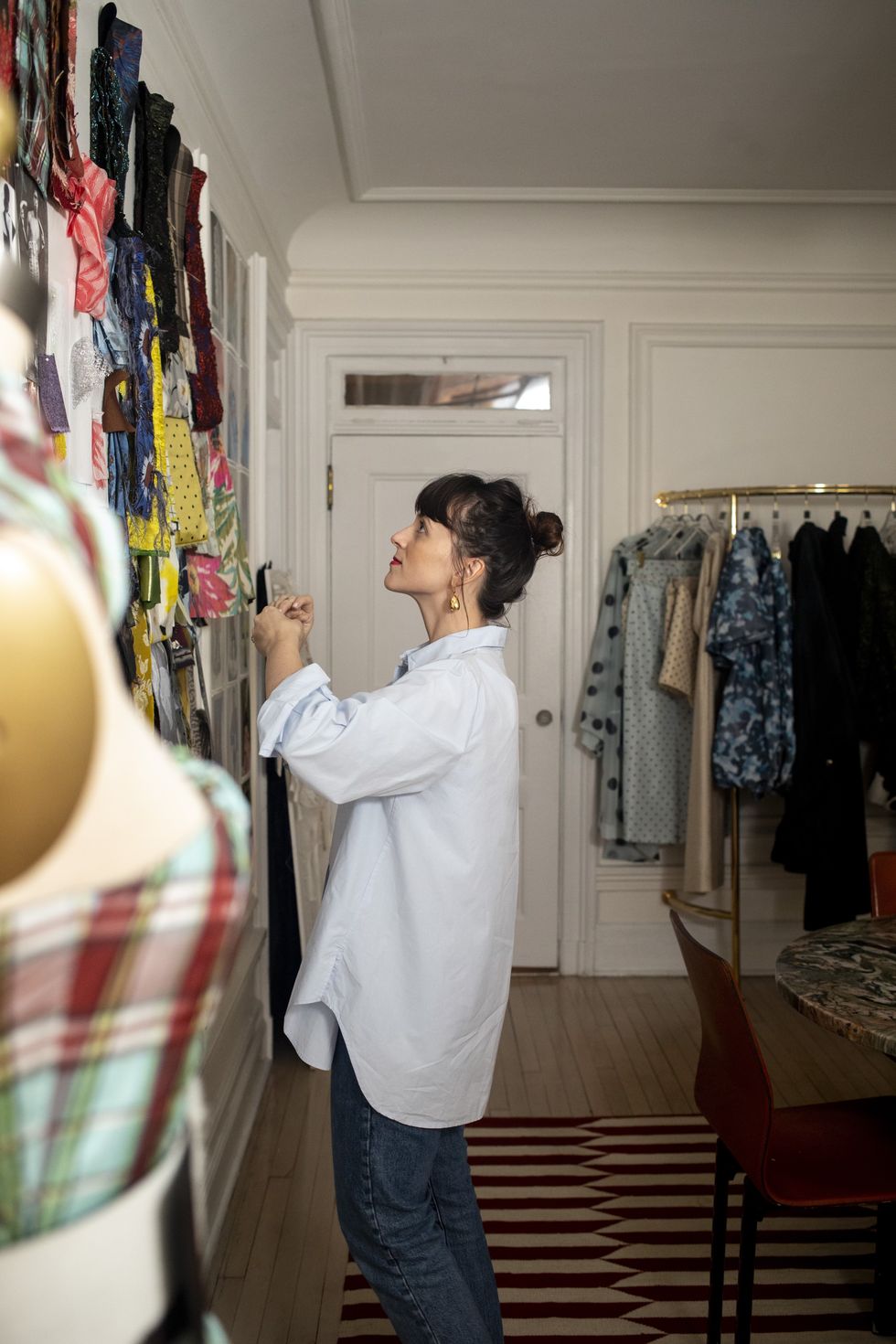
Do you collect clothes and fabrics personally?
PV: “Yes, my collection is split between my parents' house and my fiance's house in Detroit right now, because there's no more room here. It's another one of those slow builds. I collect very season-specific things that I've fallen in love with. Everybody says old Prada, but that's one of the things that I collect. I'm always looking for really niche things. I have a weird obsession with the brief period of three years Alexander Wang was at Balenciaga. Those pieces were so beautiful. And then I love Pauline Trigere, Ossie Clark stuff. I also collect small remnant fabrics from the eighteenth century. It might be the size of an index card, but it's” so beautiful and precious, I have to have it. I like beautiful things to be around. It's hoarding, for sure.
You have these beautiful fabrics from 150, 200 years ago. Where do you find that stuff?
PV: “I look all over. We have a few antique dealers that we work with. I also love going to vintage shows. Obviously, traveling to Europe, those flea markets always have amazing things, and that's where vintage dealers here are going, too. Also oddly on Etsy; it's a great resource, and as not-sexy as that sounds, there's a lot of really fun quirky people that you build relationships with. That's the best part, working one-on-one with people so that they think of you versus you constantly having to check in. And then my family. My mom has old textiles from my great-grandmother who was a seamstress. My grandmother used to make all these beautiful doilies, and we have all of those. It's been this, again, slow build, and it’s very much relationship-based.”
Well, I want to go back to what you said. Do you have a lot of fashion or clothing-oriented people in your family that kind of lit this fire in you?
PV: “My parents are entrepreneurs. So I think from a creative perspective, yes. My mom has amazing taste, so did my grandmother, my great-grandmother on both sides. My grandmother on my father's side would teach us how to stitch. We would use napkins to practice. My whole family is, I'm going to say, creative-adjacent with the exception of my great-grandmother who was a seamstress. My mom is incredibly creative, and I think I get a lot of it from her from an aesthetic standpoint. And then my dad is creative and very strategic from a business standpoint. So both worlds, both minds, which I think are important, were definitely there. But my sister's a lawyer and my brother works in tech, so they couldn't be more opposite.
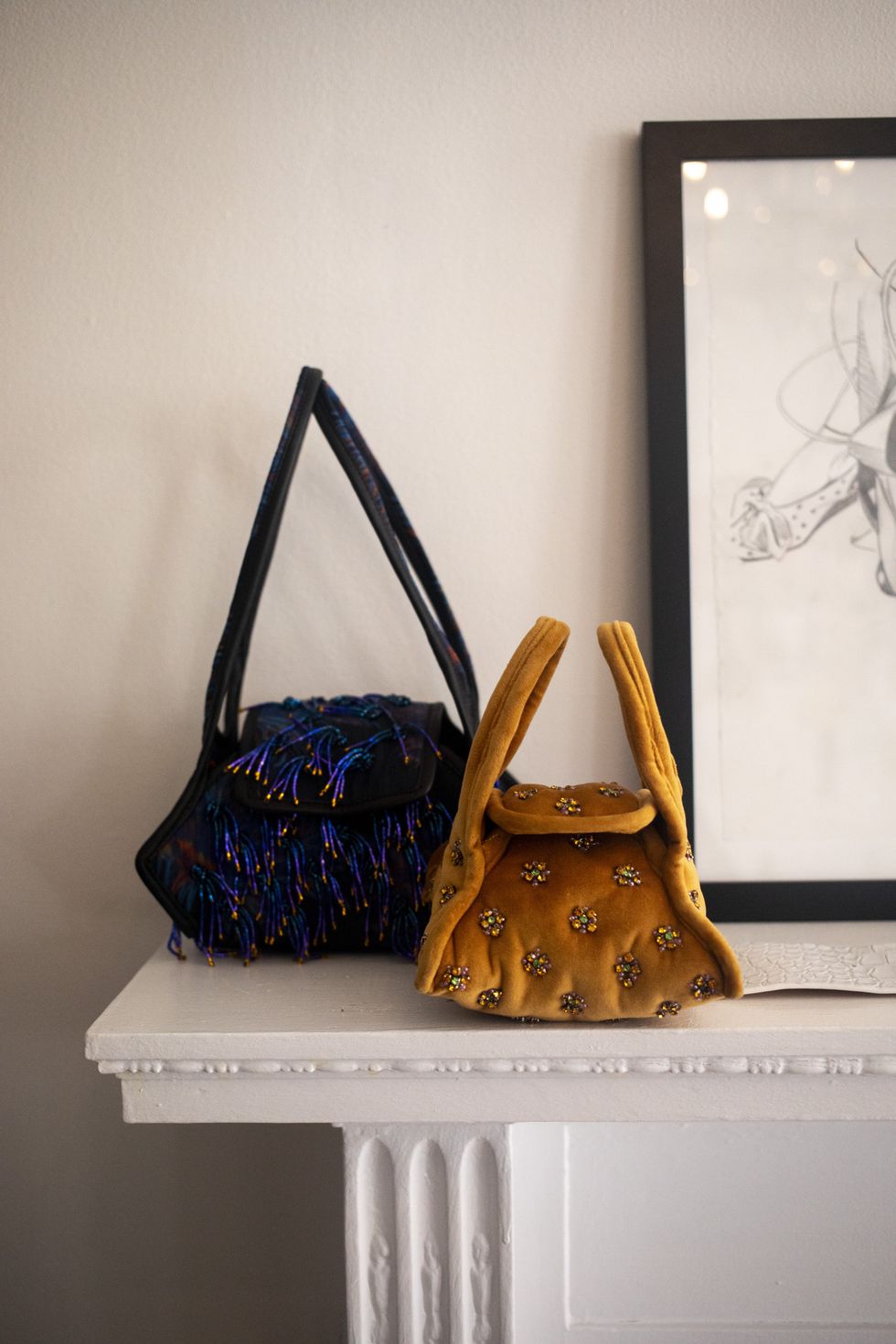

Has it been tough on your own to have to have a mind for that, like the more logistical side of things while trying to keep the creative side flowing?
PV: “At all the brands, it was my job to handle not only helping them see their vision through the fun, creative stuff, but I was in charge of budgets; I helped with the planning of each collection; I worked with the merchants, the sales team. My job was so involved with the business, almost equally divided between the two. It comes naturally to me, and I think that's why we've been able to keep the team as lean as we have; we wear many hats. I still do some of the bookkeeping. I think that we've been able to grow slowly and steadily with me running it, because the first thing that a lot of people I've spoken to that potentially could have come in say is ‘scale, scale, scale’ and that word scares me. I don't want to do that with this business right now. Let's be slow. Let’s be steady. We'll get to scale.
How did you go about carving out that role of facilitator—or give me a different word if that is how you would describe it—but how did you make that role for yourself in these different brands?
PV: “It came really naturally. When I started at Altuzarra, I was one of his first employees. We worked out of his apartment in Murray Hill. I was a PR intern at first. I didn't get to work with Joseph initially. It very slowly became helping with anything he needed me to do. It could be making sure the studio was set up for that meeting, or designing a print for the next collection. I was just so eager to be participating, and I loved that I got to wear many hats. When you're at these brands at early stages, you've got to be down for whatever. You don't know what the day is going to bring. That kind of attitude allowed me to gain amazing exposure, and I wouldn't trade it for anything in the world. Joseph took me along for the ride.
I didn't have formal training in fashion. I studied furniture design at Parsons and got my knowledge from interning at different brands. I think because the work ethic was there, he really was okay with me learning. I moved to Italy to help grow the team when Kering partially acquired the company. After that, I then was like, ‘Okay, we're getting bigger. I don't need to wear as many hats. Let me move on to the next one where I can wear many hats again.’ That's when I ended up at Brock. So I think that desire to be a little bit in the weeds but also in that really critical moment of a company where it's about to grow, has always been fascinating to me.”
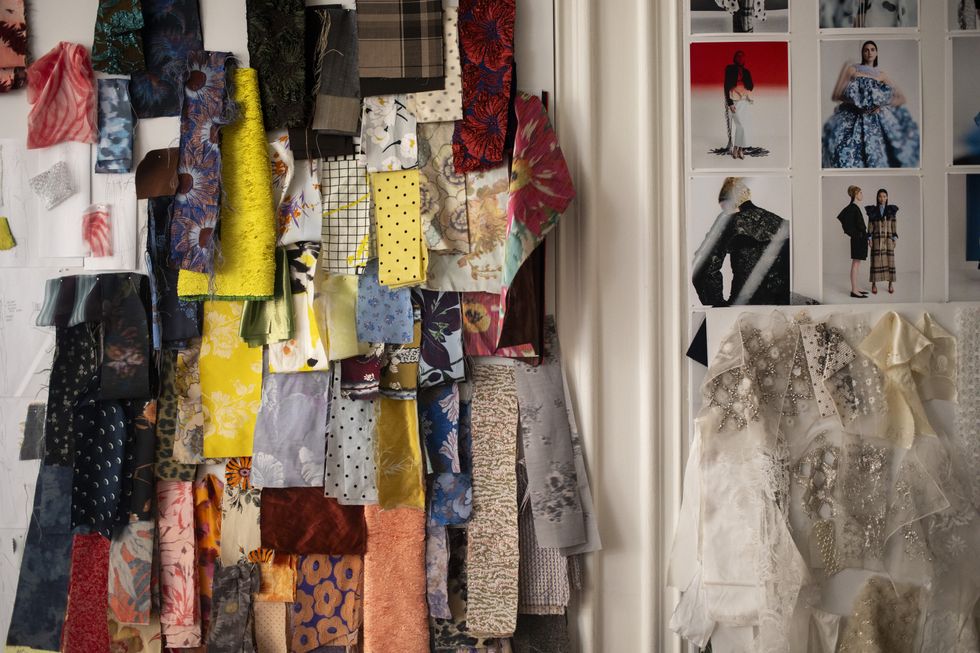
What knocked you from interiors to fashion? Obviously, I know it was through the internships, but I'm curious to hear your thought process. I think about this a lot as someone who loves interiors and fashion, but I think interior design is just a slower, more, I don't know, thoughtful process. "Thoughtful" is the wrong word, but are there ways that you feel like you almost function more like an interior designer?
PV: “To answer the first question, I intended to study fashion at Parsons. They make you take a foundation year where you get to kind of see all the different routes you can take. There's a class called 2-D. In my class, there were all these other students who wanted to study fashion, and they were so cutthroat and competitive that I said, ‘Oh, there's no way. I won't survive if this is what I'm up against.’ I'm shy, I'm soft-spoken. I'm too much of a lamb to make it with all these kids. I was really excelling in a class called 3-D where we were making all of these more hard-line forms. And my professor, who is an architect, told me I had a knack for it and that I should consider product design.
I always intended to be in fashion and then I fell in love with furniture and all of that along the way, so that's where I've kind of danced back and forth. It's not to say that fashion isn't intentional, but there's a lot more parameters, factors, variables that you have to be really thinking of when you manufacture furniture versus clothes. You can't really shorten a chair if it comes out too tall, right? A dress you can hem, you can pin, you can mend, you can tailor. A lot of these hard-line goods, you can't really have that same modification process. And so I think that that's where you see there's a little bit more of a slower build to it.
The process is also more costly. The manufacturing of it overall can be really expensive. But at the end of the day, a lot of the materials that you use between the two are the same—mills that make fabrics for apparel also make a lot for interiors. There's also this strange world in which it's more expensive to do interiors. And I can't really pinpoint, at least on the fabric side, why, but I found that really funny. I like to think about us as this hybrid. Because I think this ultimately is a lifestyle at the end of the day. Interiors really matter to us. So using our textiles as the benches, as the coverings, the curtains, all of that has been really important.”
I'm so curious about your relationship with the bridal market, because your collections don't have specifically bridal looks, but what a great entry point for all of these customers that could buoy your business. What do you think about this world, and how have you engaged with it?
PV: “We didn't set out to do bridal at all. When I was talking about this idea back in 2017, trying to get the mills to understand what we were doing, bridal wasn't on my radar at all. I was dating someone. I wasn't even thinking about weddings. It started with a friend, Cynthia, who's a bridal stylist. We knew each other from Brock, and she had a client who wanted something custom. I thought, ‘It's basically something that we already do, just making it in white, right?’ It's generally a once-in-a-lifetime moment, so to have that privilege of helping somebody with such an important occasion—I'm just grateful that they think of us.
I don't mind a theme. I love to tap into that. For a lot of our younger brides, we might do a bra and a skirt with them, and this might be a little bit of a reach. They wouldn't shop like this on a normal basis, and so it might be our entry-level product, but we treat it as if it's the most expensive thing in the space, because I recognize that. I want them to have an equally special experience. There are brides who spare no expense, who want the most crazy elaborate things on the other extreme end of it all, and they're equally as fun to work with as the one who comes in for just the bra. I know them all by name. I work with them all personally. It's half of our business.’


Well, I have to ask if you're engaged, do you know what you're wearing for your wedding?
PV: “I was talking about how I love Alexander Wang’s Balenciaga? I managed to get a piece from one of the slinky white looks that he did. Will I wear it or not? That will depend on if we ever get married. I don't envy the amount of work that goes into a wedding. My fiance and I are not in a rush by any means, and just enjoying the engagement part of it.”
I love asking female designers this, and I think you have an interesting perspective because you work so much with individual clients. When you're designing your collections, do you design for yourself? Or do you have a One/Of girl in mind? Or do you just do it product by product?
PV: “A little bit of both. I think it's important that I would like to wear it. Also, I'm a realist. Will all the things I like to design necessarily look good on me? Probably not, but will they look good on other people? Yeah. I try to be really thoughtful about everything that we create. And I think because I select and source all of the fabrics, and that becomes our jumping-off point, there is a very clear perspective and point of view. That curation is what feels most true to me and One/Of. From a silhouette standpoint, I might not be designing necessarily with one person in mind, but we are often inspired by other clients' pieces, too. We might've made something custom for a client that I loved so much I did another version of it for a capsule. It can go a lot of different ways, but fabrics are the key thing.”
Absolutely. Are there certain One/Of pieces that you've worn a million times?
PV: “Yes, and there's so many that I didn't get to wear a million times because I'll make them for myself and that's the piece that a client will come in and say, ‘The one you're wearing is so cute. Can I have that? ‘Sure. I'll get that dry-cleaned and right over to you.’ We do these oversized shirts, which I just love. I wear a lot of denim, because I'm rolling all over the floor all day long. The shirts are a really easy way to have something that feels on brand but comfortable. When it comes to evening stuff, I love our tie-back shirt because it's a cool interpretation of a T-shirt that you can dress up and dress down. When I have a shape that I like, I cut it in several colors and fabrics and materials; I'm very much a uniform dresser, and people tend to get sick of seeing me in the same thing.”
What are the brands you most often mix in with your own pieces, personally?
PV: “I have a lot of Gabriela Hearst, and Brock, too. I wear a lot of knits, which are mainly Gabriela Hearst and Brock. Khaite jeans fit me really well, and then I have vintage denim, too. If I'm going to buy something, it's often pre-owned. I just got a cool JW Anderson dress from 2010.”
In your own time, what are your hobbies and pastimes? Are you rifling through a million Pinterest boards, or going through vintage markets? Or do you have to decompress and binge-watch something stupid?
PV: “I'm obsessed with reality TV. I cannot get enough of it. Give me any West Coast-based realtor on Netflix, and it's pure heaven for me. I'm a Love is Blind girl. Give it all to me. My other favorite thing to watch is singing competitions. I'm obsessed with The Voice and American Idol, which thankfully are both running right now so I watch those on rotation. I'm fascinated by people who can sing. It's like watching Chef's Table. Cooking is another thing for me. I can't cook at all, and I love people who can cook. I find it so incredible, such a great skill.”
Want more stories like this?
A Stylist’s Secret Weapon
Is Black the Most Fashionable Color?
Why Fashion Is Going Back to the Future

